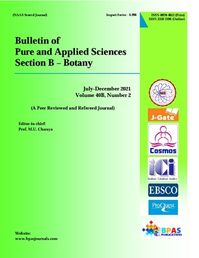Effect of Heavy Metals (Cu, Zn and Cr) on Total Carbohydrate and Protein Content in Andrographis paniculata (Burm. f.) Wall. ex Nees
DOI:
https://doi.org/10.48165/Keywords:
Heavy metal pollution, Total carbohydrate content, Protein estimation, AndrographisAbstract
Andrographis paniculata (Burm. f.) Wall. ex Nees is a medicinal plant that is used to treat various diseases like diabetes, hepatitis, and fever. The current study is aimed to identify the effect of three selected heavy metals Copper, Zink, and Chromium on the total carbohydrate and protein content in Andrographis paniculata. Concentrations selected for the analysis are 25ppm, 50ppm, 75ppm, 100ppm, 125ppm, 150ppm and 175ppm. Heavy metal treatment was done in the hydroponics method which was carried out in glass bottles. Modified Hogland Solution (Epstein, 1972) was used as a nutrient medium for hydroponics culture. Plant samples for the carbohydrate and protein content estimation were collected at 10-day intervals. The study shows that 25 ppm Cu causes a very slight increase in carbohydrate content as compared to control and from 50 ppm Cu treatment causes a lowering of carbohydrate content. Zn and Cr cause a lowering of carbohydrate content even from 25ppm. The protein content is found to be increased in all three heavy metal treated plants at lower concentrations. From the concentration higher than 125 ppm Cu and Zn cause lowering of protein content. The plants treated with Cr show a lowering of protein content from 75ppm concentration.
Downloads
References
Bradl, H. B. (2005). Heavy Metals in the Environment: Origin, Interaction and Remediation, Elsevier Academic Press.
Calabrese, C., Berman, S., Babish, J., Ma, X., Shinto, L., & Dorr, M. et al. (2000). A phase I trial of andrographolide in HIV positive patients and normal volunteers. Phytotherapy Research, 14(5), 333-338.
Chiou, W. F., Lin, J. J., Chen, C. F. (1998). Andrographolide suppresses the expression of inducible nitric oxide synthase in macrophage and restores the vasoconstriction in rat aorta treated with lipopolysaccharide. British Journal of Pharmacology, 125(2), 327–334.
Epstein, E. (1972) Mineral Nutrition of Plants: Principles and Perspectives. John Wiley and Sons, New York.
Gupta, S., Choudhry, M., Yadava, J., Srivastava, V., & Tandon, J. (1990). Antidiarrhoeal Activity of Diterpenes of Andrographis paniculata (Kal-Megh) against Escherichia coli Enterotoxin in in vivo Models. International Journal of Crude Drug Research, 28(4), 273-283.
Kamdem, R., Sang, E. S., Ho, C. T. (2002). Mechanism of the superoxide scavenging activity of neoandrographolide a natural product from Andrographis paniculata nees. Journal of Agricultural and Food Chemistry, 50(16), 4662–4665.
Lowry, O. H., Rosenbrough, N. J., Farr, A. L. and Randall, R. J. (1951). Protein measurement with Folin-Phenol reagent. J. Biol. Chem. 193, 265-275.
Masuko, T., Minami, A., Iwasaki, N., Majima, T., Nishimura, S., Lee Y C. (2005). Carbohydrate analysis by a phenol sulpuric acid method inmicroplate format.) Anal. Biochem. 339(1), 69-72.
Sharma, A., Singh, R. T., Sehgal, V., Handa, S. S. (1991). Antihepatotoxic activity of some plants used in herbal formulations. Fitoterapia, 62(2), 131–138.
Taiz, L. and Zeiger, E. (2002). Plant Physiology: (IIIrd Edn.) Sinauer Associates, Inc. Publishers, Sunderland, Massachussetts.
Wiart, C., Kumar, K., Yusof, M. Y., Hamimah, H., Fauzi, Z. M., M. Sulaiman, M. (2005). Antiviral properties of ent labdene diterpenes of Andrographis paniculata Nees, inhibitors of herpes simplex virus type 1. Phytotherapy Research, 19(12), 1069–1070.
